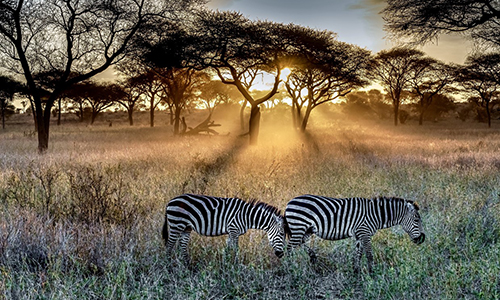Our driver will pick you up from your hotel before the sun rises, and in the comfortable vehicle, you’ll observe the life waking up on your way to the park. After entering the park through the Bachuma gate you will immediately start with your game drive. Look out for the famous maneless lions, red elephants, cheetahs, giraffes, antelopes, zebras, and much more. The drive will take you to the famous Aruba dam over the river Voi – an important water source, where, especially during the dry season, lots of animals can be observed.
Just when the heat starts to pound in, we will take you to a restaurant lunch, and after being filled with new energy, you will go for another game drive, to look for the animals not yet seen. There’s a good chance to see all of the big five here, and an abundance of life all around.
You will then say goodbye to the animals and we’ll bring you to your hotel in Mombasa or a beach resort, or the airport.
Details of Tsavo East and West National Park
Land of Lava, Springs and Man Eaters. The twin parks form one of Africas largest wilderness reserves consisting of 10 million acres of pure wilderness made of savannah, range and hills, acacia, montane forest and extensive river system. They cover 4% of Kenya’s total land area of 11,747sq.km in the Southeast of Kenya. Rising to 1,200 m above sea level, it has warm and dry climate and features bushy grasslands, open plains, semi-arid acacia scrubs and wood lands.
Wildlife
The Park is home to most of larger mammals, vast herds of dust red-red elephant, Rhino, buffalo, lion, leopard, hippos, waterbucks, Kudus, Gerenuk and Hirola.
The ‘Man-Eaters’ of Tsavo
The Park acquired its name ‘Tsavo’, meaning ‘slaughter’ from the Akamba people, who first migrated to the area some five centuries ago – long before the arrival of the more famous leonine slaughterers, the ‘Man-Eaters’ of Tsavo.
Man Eaters of TsavoThis historic railway was, in 1899, the scene of one of Africa’s greatest Adventure stories where two large lions actively preyed on the railway workers as they built a bridge over the Tsavo River, claiming over 120 victims. They evaded hunters for well over a year, and the legend of the Man eaters of Tsavo was born. The Park is therefore famous for its numerous pride of mane-less lion Tsavo East is the larger of the two, dramatically presents a theatre of the wild.
Largest safari elephant herds in the world
It offers a vast arena of parched scrub and heat-shimmering bush which is washed by the azure waters and emerald-fringed meanderings of the Galana River, guarded by the limitless lava reaches of the Yatta Plateau and patrolled by some of the largest safari elephant herds in the world.
Unlike Tsavo West it is the epitome of the African bush, with mile upon mile of arid, thorny scrubland sweeping to the horizon. On the other hand Tsavo West Park lies on the western side of the Mombasa – Nairobi Highway and is painted on a sprawling canvas of endless skies, emerald hills, liquid lava flows, palm-fringed rivers, teeming wildlife and sparkling oases, set against the unforgettable backdrop of mile upon mile cloud-shadowed African savannah. Elephant in Eden
You see the sights of dust – red elephant wallowing, rolling and spraying each other with the midnight blue waters of palm-shaded Galana River – one of most evocative images of Africa.
The Aruba Dam
The beautiful 85 hectare man-made dam located on the north bank of the seasonal Voi River. It is visited by thousands of animals and birds making it a great game viewing destination.
The Mundanda Rock
Here is where wild animals usually go to before embarking on a quest for water especially during the dry season. The whale-backed rock towers above a natural dam and acts as a draw to thousand of elephants.
The Yatta Plateau
Is the longest lava flow in the world at 300kilometres in length and 10kilometres wide, formed when the flow cooled and solidified, it was left standing as a ridge after the surrounding land was washed by erosion making it a marvelous spot for picnics and a sundowner.
The Lugard Falls
Named after Captain Lugard the first proconsul to East Africa, the falls feature white water ranging through eroded rocks and plunge into forming rapids and crocodile infested pools.
The Galana River
Which is a formation of the Tsavo and Athi Rivers above the Lugards Falls before flowing into the Indian Ocean. The Galana River is the color and consistency of chocolate milk, even in the dry season.
Tsavo West Attractions
- Tsavo is a birdwatcher’s paradise.
- Mzima springs offering millions of fresh water every day.
- Recent Volcanoes, lava flows and caves.
- Birdlife Tsavo is a birdwatcher’s paradise with prolific bird life featuring 500 recorded species in the East and 600 in the West. Species include weavers, hornbills, sunbirds, rollers, and raptors.
- The lions, leopard, cheetah, wild dogs, buffalo, rhino, giraffe, zebra, crocodile, mongoose, hyrax dik dik, lesser kudu and nocturnal porcupine.
- The African skimmer, goshawk, red and yellow bishop, palm nut vulture and the white-headed buffalo weaver, woodpecker, sunbird, starling and pigeon, Maasai and Somali ostrich abound along with kori bustard, bateleur, carmine bee-eater and an East African specialty, the vulturine guinea fowl are commonly seen.










